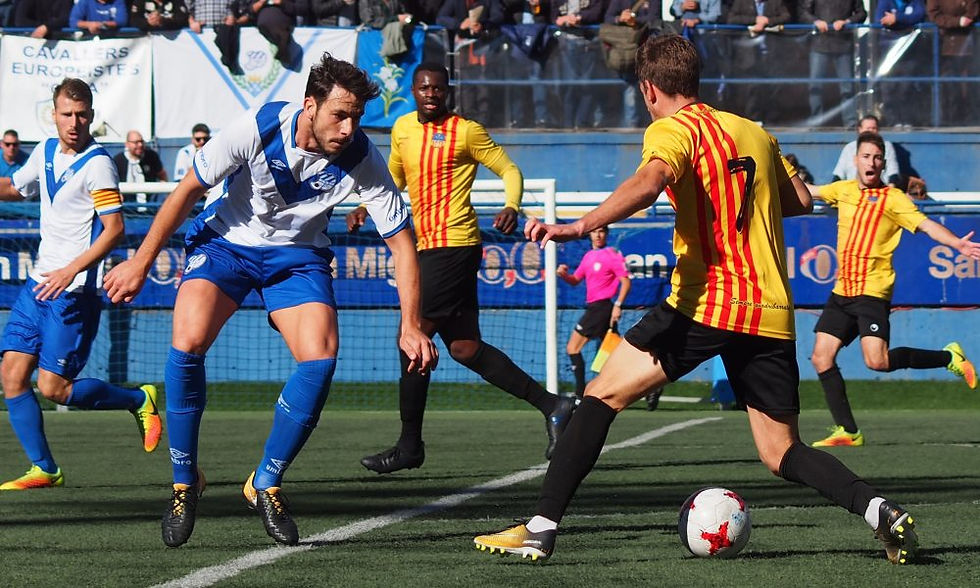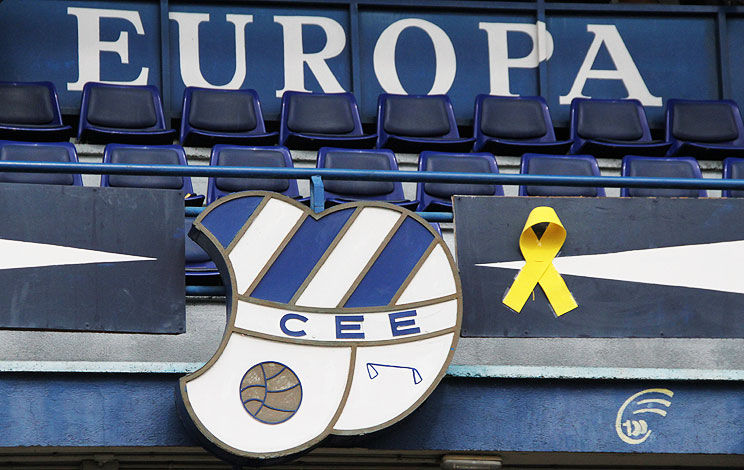The Authentic Derby of Barcelona
- Cody

- Nov 11, 2017
- 4 min read
Updated: May 21, 2018
Away from the bright lights of the Camp Nou and the suburbs of Cornellà, two historic Catalan clubs seek bragging rights in a city that they don't even feel apart of.
Barcelona, one of the most globally revered footballing cities, holds a special derby. You’d be forgiven for assuming that it was contested between the two La Liga giants, FC Barcelona and RCD Espanyol. Yet, the authentic derby of the Catalan capital consists of two clubs that were founded in towns that were once independent of the city itself. Two barris where you can feel a spirit of independence, proudly shown every other weekend on the terraces of the Nou Sardenya and the Narcis Sala. Two groups of supporters that share a mutual animosity for each other and for no obvious reasons. Club Esportiu Europa from the neighborhood of Gràcia and Unio Esportiu Sant Andreu of Sant Andreu - two historic Catalan clubs who are more similar to each other than they’d like to admit.
Ser de Gracia es molt millor

To be from Barcelona is really easy, to be from Gràcia is much better.
The Vila de Gràcia, or the Village of Gràcia, was officially swallowed by the city of Barcelona in 1897. Often considered to be the “bohemian” neighborhood of Barcelona, graciencs hold tightly onto their traditions and, in many ways, their independence. Fittingly, CE Europa and its supporters reflect this sense of separatism. A chant heard each weekend on the terrace goes, “Ser de Barcelona es molt facil, ser de Gràcia es molt millor (To be from Barcelona is really easy, to be from Gràcia is much better)”.
Fall from Grace
Europa can be considered something of a fallen giant in Spanish football. Formed in 1907, the club was a founding member of Spain’s top flight in 1929, alongside the current La Liga duo of Barça and Espanyol. The club never reached the same heights after the Spanish Civil War. Today, the escapulats sit in the Tercera Division, curiously named as it is actually a massive fourth division.
Defending the Quadribarrets

A ten-year history of tifos and social campaigns, particularly against the rising costs and monetization of modern football, have made the group recognized throughout the Spanish ultras community.
Sant Andreu, like Gràcia, is a former town which was brought into Barcelona’s administration upon the city’s expansion in 1897. And like Gràcia, andreuencs will tell you that Sant Andreu is not Barcelona. If fact, a sticking point between the two sets of supporters is who was actually the last one to be independent of Barcelona. Both choose dates that fit their narrative. Sant Andreu has always been and remains a working-class area, an image that its football club is proud to uphold.
UE Sant Andreu, founded in 1909, is one of the historic clubs on Catalonia, despite having never played in Spain’s highest division. UESA boasts what must be considered the most dedicated set of ultras in the Tercera, if not in Catalonia. The desperdicis, which can best be translated as the wasted, have an impressive number of members for a fourth division side. A ten-year history of tifos and social campaigns, particularly against the rising costs and monetization of modern football, have made the group recognized throughout the Spanish ultras community. And like their opposite number, the eskapulats, the group fights for their political ideologies.
Shared Politics, Mutual Dislike

Politics and football have always been mixed in Catalonia, an idea which is not as taboo there as in other parts of the world. The football stadium has always offered the supporters a chance to express their political and social views. In this regard, the majority of ultras of both Europa and Sant Andreu can be described as Catalan independentistas (and naturally anti-Spanish), anti-fascist, anti-racist, pro-feminist, and supportive of the working class. Essentially, very much to the left. All of which makes the two sides dislike for each other all the more paradoxical.
Whether or not these ultras groups and their politics enact any meaningful social changes is many times unclear and, perhaps, irrelevant. For ultras, their club offers them the opportunity to express themselves in the public sphere. At the very least, they can bring about positive changes within the football stadium.
When Derby Day Comes

Sant Andreu understands the value of a derby victory this Sunday and not just for local pride. Last seasons match against Europa at the Narcis Sala ended in a heated 0 - 0 draw that, like so many local derbies, swapped passion for quality. In fact, the last five derbies have ended in draws, four of them goalless. The match took place with just four matches to go and the result pushed the andreuencs out of a playoff position, which they never regained. Europa secured their own safety but are looking to return to the form which got them into the promotion playoffs the previous two seasons from 2014 to 2016. As of now, U.E.S.A sits in 6th with 25 points and C.E.E are on 22 points down in 9th, both still very much in contention for a top-four finish.
Perhaps their similarities foster the rivalry. Like growing up alongside a brother you’ve always got to one-up, Europa and Sant Andreu are two clubs who share a similar history and hold onto the characteristics of their neighborhoods. Sunday at the Nou Sardenya both sets of supporters will be sure to let the other know just who are the authentic kings of the city, albeit one that they don't feel apart of. Here’s to anything other than another nil - nil draw.
Where: Estadi Nou Sardenya, Gràcia, Barcelona
When: 12 p.m. local time (6 a.m. US Eastern)
How: Online via Beteve Esports website or YouTube channel





Comments